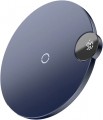Power (with 1 device)
The maximum power that the charger is capable of delivering to one rechargeable gadget (for models with 1 connector or with 1 wireless platform — the actual charging power). We emphasize that for wireless devices, it is the power in the wireless format that is indicated here (even if the design has a USB port with a higher power). Wired chargers usually list the USB power with the highest charging current or with support of the most powerful fast charging technology.
The smallest value of this metric nowadays is actually
5 W. Other popular options include
10W,
12W,
15W, and the most powerful models have
18W or more
to charge laptops(up to
100W).
Higher output power allows you to speed up the charging process; and in the case of wireless devices, a value of more than 10 watts already allows us to talk about the presence of fast charging. At the same time, a number of nuances are associated with this parameter. Firstly, not only the charger, but also the gadget being charged should support the appropriate power — otherwise the speed of the process will be limited by the specs of the gadget. Secondly, in order to use the full capabilities of the charger, it may be necessary to support not only the appropriate charging power, but also a
...certain fast charging technology (see "Fast charging"). Thirdly, in a charger with several charging connectors, the maximum power per device can only be achieved if the other ports are not used.Features
—
Operation indicator. In some models it also provides additional information about operating modes, malfunctions, etc. Most often, such a light indicator is in the form of a separate light or a clearly visible backlight system. And additional information can be provided by changing the colour of the backlight, by blinking, etc. However, even without these features, the operation indicator provides additional convenience in use. In particular, it allows you to determine whether the charger is receiving power and working normally — this can be useful when diagnosing various problems. It is also possible to use non-standard backlighting — for example, as a night light that makes it easier to navigate in an unlit room (especially since gadgets are often put on charge just at night).
—
Display. Own display on the charger case. This is usually the simplest screen with a few characters, but it is enough to display various additional information that makes life easier for the user: current voltage and current values, fast charging status, error codes, etc. On the other hand, this complicates the design, but in fact such information is required less often; Therefore, very few chargers with displays are produced.
— Detachable charger power cable. Cable for connecting the charger to the power source, which has a removable design. By itself, connecting to a power outlet using a separate wire (both re
...movable and non-removable) is rarely used in charger devices — mainly in devices for which the “plug on the case” type design is not suitable (this is primarily wireless models, as well as wired charger devices with an abundance of connectors and corresponding dimensions). Specifically, the removable design is convenient in two ways: firstly, the wire can be removed and compactly folded for storage and transportation, and secondly, if the cable is damaged, it can simply be replaced, no need to bother with repairs. The disadvantages include an increased probability of losing the cable, as well as a slightly lower reliability than with a non-removable design (the latter, however, becomes noticeable only with frequent connections/disconnections that wear out the connector).
— Non-detachable charger power cable. Cable for connecting the charger to the power source, rigidly fixed to the device and not intended to be disconnected. It occurs much less frequently than the removable one described above, since it is less convenient if necessary to compactly fold the device; and if the wire is damaged, most likely, you will have to carry the charger to a service centre. On the other hand, you can lose such a wire only together with the charger itself.Charger connection port
Port used to connect the power cable to the charger. This parameter is indicated mainly for wireless models, including car models (see "Type"), but it can also be relevant for other varieties — in particular, individual docking stations.
In general, when choosing, this parameter does not play a decisive role: a power adapter with the appropriate plug must be supplied in the kit. However, information about the power plug can be useful when looking for a spare or replacement power source. The options here might be:
— USB-C. One of the miniature varieties of the USB connector; microUSB differs from similar in many respects primarily in its two-sided design (which allows you to connect the plug to either side), as well as in smaller sizes. Is a universal standard; in fact, this means that, if necessary, you can also power the charger from a “non-native” adapter with a USB-C cable – the main thing is that this adapter can provide enough power.
— microUSB. Another smaller version of the USB connector, earlier than the USB-C described above. It is considered less perfect, and therefore noticeably less often used as a power connector for wireless charger; one of the key differences is the one-way connector design, which is less convenient to connect. MicroUSB is also a common standard and allows the use of third-party power supplies.
— Lightning. Proprietary 8-pin connector used in Apple technology. However, among the chargers there are...also third-party devices with such a power connector. The meaning of this design is that, if necessary, the charger can be powered through a proprietary Apple cable, and the Apple device can be charged wirelessly.
— Original. This category includes all connectors that are not related to those described above. These can be both proprietary interfaces of a particular company, or common, but at the same time rare standards. One of the most popular types of such a plug is cylindrical, similar to the DC power connector (although not necessarily identical in size and design). However, anyway, this connection method does not allow the use of third-party power adapters, and therefore is not particularly popular.
Cable length
The length of the cable supplied with or included with the charger. For wireless models, the length of the power cable of the charger itself is indicated here, for wired models, the length of the cord for charging gadgets
Anyway, a longer cable gives more freedom of movement, but it creates inconvenience for short distances. Also note that charging is supposed to be used in the immediate vicinity of sockets, so wires longer than 2 m are practically not found among such devices. A length of
more than 1.5 m is considered significant, from 1 to 1.5 m — medium, from 0.5 to 1 m — small, and in some models there are wires shorter than 0.5 m.

